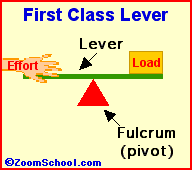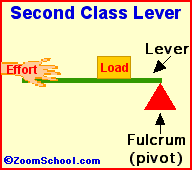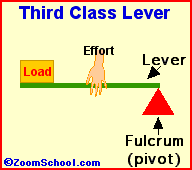A lever is a simple machine that makes work easier for use; it involves moving a load around a pivot using a force. Many of our basic tools use levers, including scissors (2 class 1 levers), pliers (2 class 1 levers), hammer claws (a single class 2 lever), nut crackers (2 class 2 levers), and tongs (2 class 3 levers).
 A Type 1 Lever. |
 A Type 2 Lever. |
 A Type 3 Lever. |
 A Type 1 Lever. |
| Item | Number of Class 1 Levers Used | |
|---|---|---|
| see-saw | a single class 1 lever | |
| hammer's claws | a single class 1 lever | |
| scissors | 2 class 1 levers | |
| pliers | 2 class 1 levers | |
 A Type 2 Lever. |
| Item | Number of Class 2 Levers Used | |
|---|---|---|
| stapler | a single class 2 lever | |
| bottle opener | a single class 2 lever | |
| wheelbarrow | a single class 2 lever | |
| nail clippers | Two class 2 levers | |
| nut cracker | Two class 2 levers | |
 A Type 3 Lever. |
| Item | Number of Class 3 Levers Used | |
|---|---|---|
| fishing rod | a single class 3 lever | |
| tweezers | Two class 3 levers | |
| tongs | Two class 3 levers | |
